"The customer is king!"
How many times have you heard that statement before and actually believed it?
My guess… not that often.
But when a company truly means it and makes you feel like a king, it makes you feel special.
In turn, you recommend the company to your friends and family, you continue to buy from them, and you become a happy and loyal customer.
From a business perspective, the companies that treat their customers well, outperform those that don’t on almost every growth metric.
More importantly, they are 60% more profitable!
So, what are they doing differently?
It all starts with the customer journey.
First introduced more than twenty years ago by OxfordSM as part of the Eurostar development, it’s still relatively new to the business world. For example, research by Econsultancy found that 50% of organizations have little to no understanding about their customer journey.
That’s why today I’ll be sharing what the customer journey is, how to map the journey for your organization and how to use it to reduce costs, increase revenue and create a better customer experience.
What is a customer journey?
A customer journey is the complete experience a customer has with an organization. It encompasses all customer interactions across all channels, devices and touchpoints throughout every stage of the customer lifecycle – from awareness to loyalty.
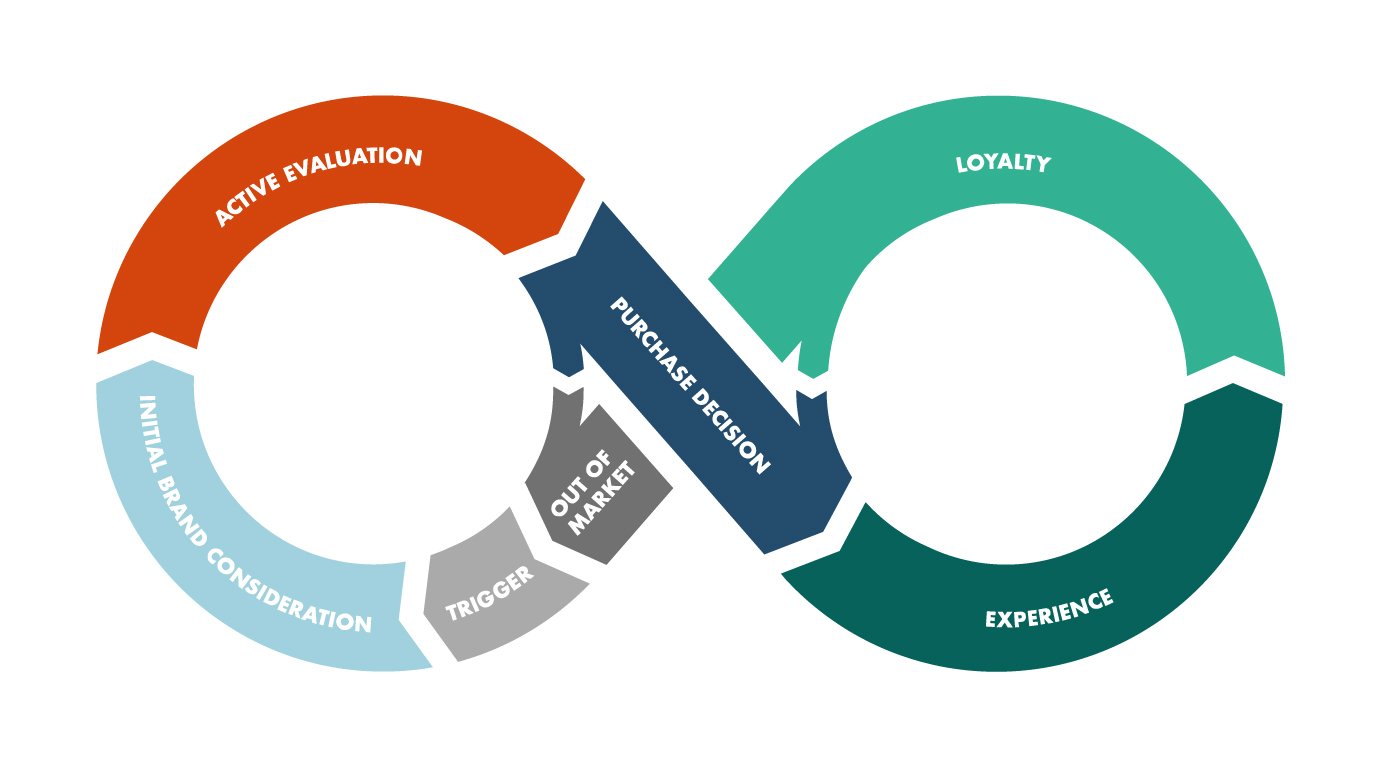
Companies use a wide range of channels to communicate with their customers, but often fail to connect each activity with the customer journey. Sales and marketing strategies become isolated from one another, which leads to a disconnected customer experience.
But, isn’t the customer journey the same thing as customer experience?
Well, not quite.
The difference between the customer journey and customer experience is this:
- The customer journey is what they do at each stage of the customer lifecycle
- The customer experience is how they feel about the entire customer lifecycle
Searching for a new pair of trainers in Google, making a purchase online and then wearing them the next day is part of the customer journey. Finding the website easy to use, being surprised with overnight shipping and feeling appreciated with a hand-written thank you note from the brand, is an example of customer experience.
And that's the kind of experience that customer's are willing to pay more for.
86% of customer's are willing to spend more on products for a great customer experience.
So, how do you make sure that the customer's experience with your company is a positive experience?
You start by mapping the customer journey.
Mapping the customer journey is the number one strategy that high performing CX execs use to improve the customer experience. If you want to be a high performer, then follow the steps below.
Mapping out customer journey can be split into 3 distinct stages:
- Drawing out the customer journey lifecycle
- Identifying company and customer touchpoints
- Analyzing gaps between existing strategies and expectations
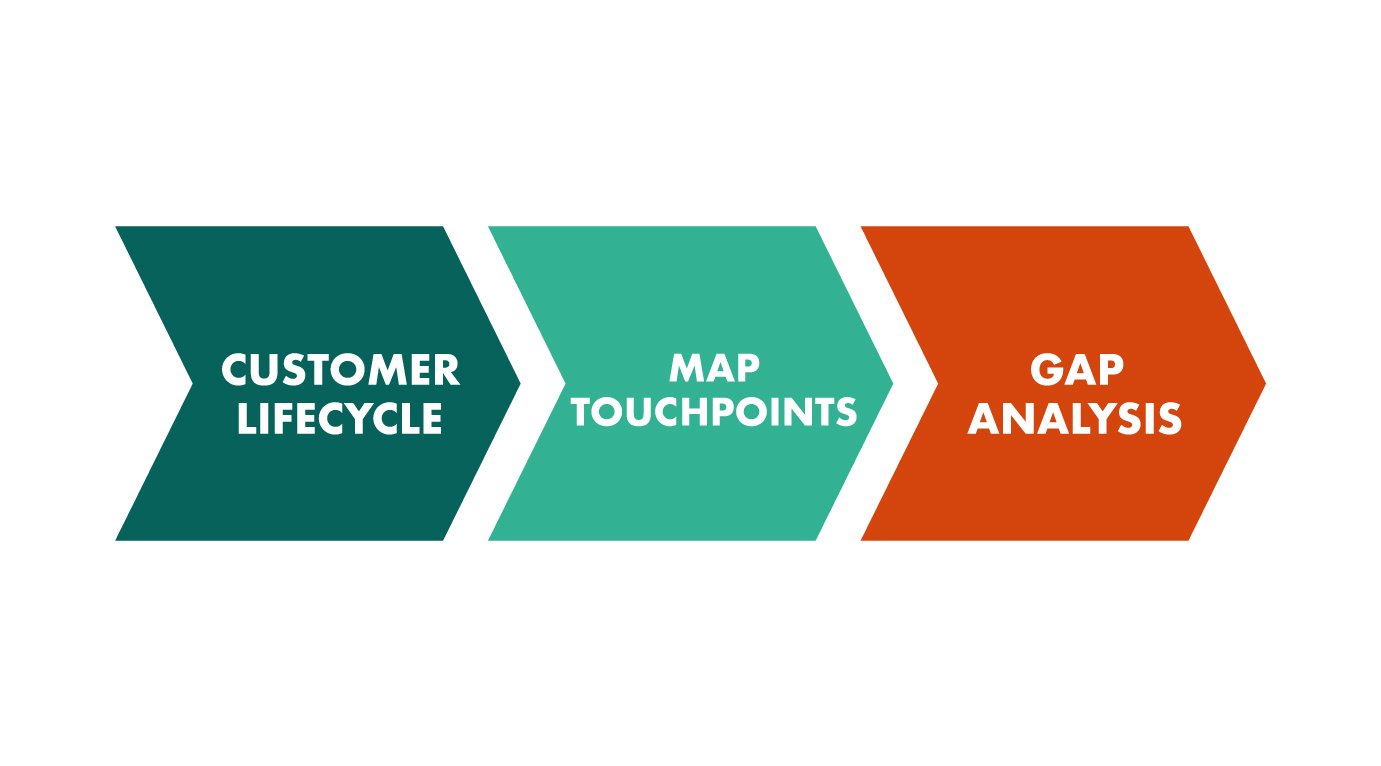
It’s important to note that the customer journey cannot be drawn out from your own perspective – it has to be drawn out from your customers’ point of view.
This means that you put yourself in their shoes and think like a customer.
To do this, you need to speak with your customers and collect what is known as voice of customer feedback.
Not sure what to ask your customers?
Here's some sample questions that we've used during our own customer journey process:
- What happened inside your company that caused you to search for a new product?
- What is your research process for finding a new product?
- How did you find [your company name]?
- How important is a free trial during your buying process?
- Specifically, what made you choose [your company] versus [a competitor]?
Hearing the steps your customers took to make a purchase with you is incredibly valuable.
Yet surprisingly, only 1 in 5 businesses collect this kind of feedback to improve the customer journey.
If you're not optimizing the journey based on what your customers do, then it's nothing more than guesswork.
Here's a great example of when guesswork (as in most cases) goes wrong.
In 2015, SuperOffice launched a free trial offering.
For more than 3 years, our main call to action on the website was to promote a free trial.
But when our Chief Marketing Officer, Jennifer Lim Lund, interviewed our customers in August 2018, we found out that a free trial is not part of the buying process for our ideal target customer. Instead, they prefer to sign up for a live demonstration. And our demo form was difficult to find.
In other words, we were making it difficult for our ideal target customers to buy from us.
Since then, we've replaced our main call to action from a free trial sign up to a demo request and by doing so, we've seen the number of requests from our target audience increase by more than double.
Optimizing the customer journey based on direct feedback resulted in 174% more sign ups from our ideal target customer.
Now, imagine being able to scale these results across every phase of the journey?
This simple interview process helped us understand our customers needs better.
Once you understand the needs of your customer in all phases on their lifecycle – you can then meet and exceed their expectations at every phase of the customer journey.
But before we go into the discussion of phases, let’s take a look at what the benefits of mapping out the customer journey are for your business.
The business benefits of the customer journey
Imagine being able to predict the next step of your target customer…
...that’s the “super” power of the customer journey!
In fact, this is the exact reason why 69% of businesses list the customer journey as a top investment priority this year.
Marketers have gone one step further, stating that the customer journey is a top priority for the next two years!
Yet, for companies that have a formal customer journey strategy, the evidence is compelling.
An Aberdeen Group research paper found that companies with a formal customer journey program experience year over year growth that includes:
- 18X faster average sales cycles,
- 56% more cross-sell and up-sell revenue,
- 10X improvement in customer service costs,
- 5X greater revenue from customer referrals,
- 54% greater return of marketing investment (ROMI).
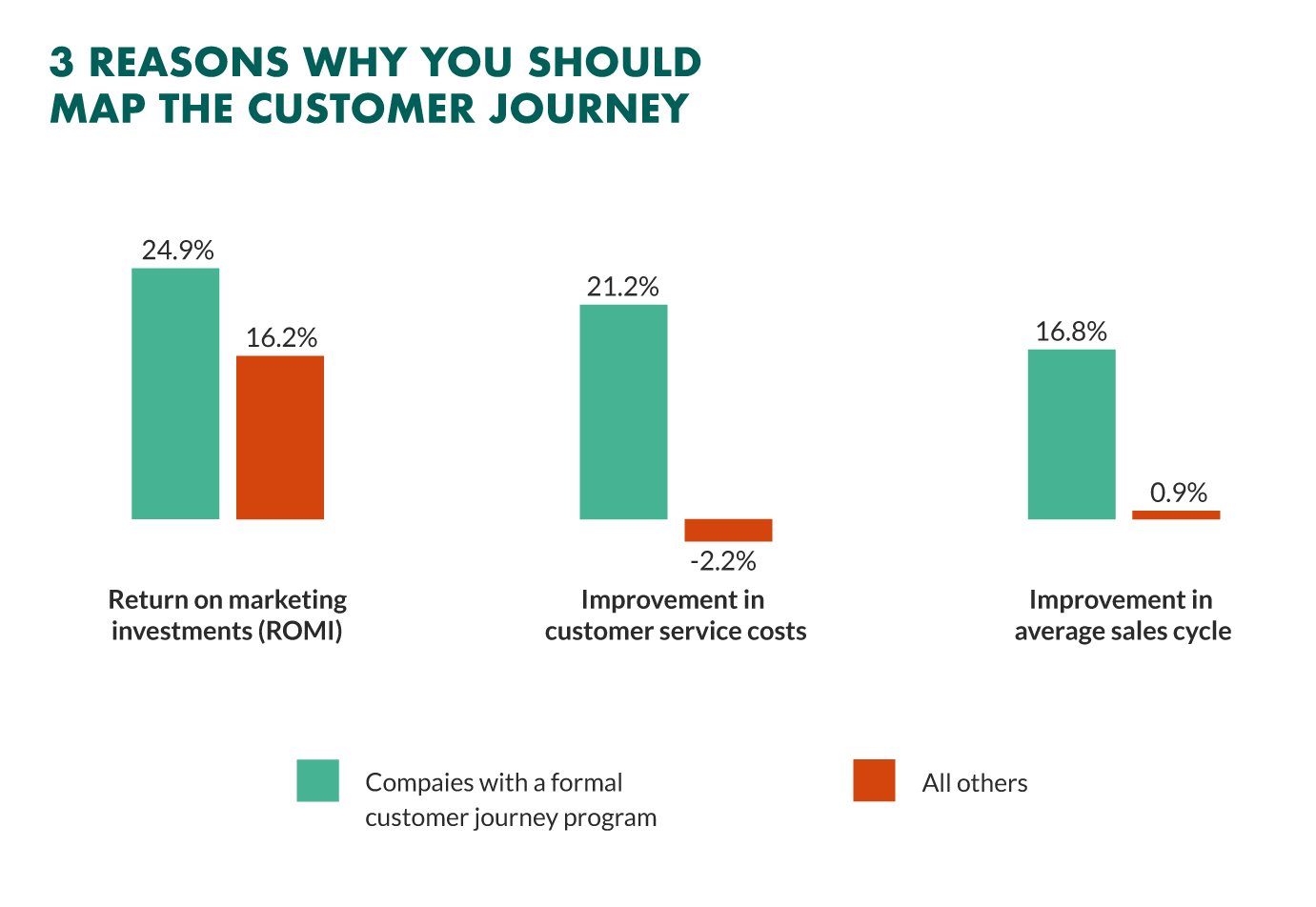
The business benefits of optimizing the customer journey are clear.
But, there’s more good news.
The same study by Aberdeen Group found that only 36% of companies have a process to map out the customer journey, making this a huge opportunity to create a competitive advantage for your business.
But what are the customer journey phases?
The 7 phases of the customer journey
The customer journey is linked to each instance that the customer comes into direct contact with your company or product:
- Before a purchase - customer's will come into direct contact with online advertising, social media, email marketing
- During a purchase - customer's will come into direct contact with sales teams, consultants and your company website
- After a purchase - customer's will come into direct contact with training material, follow-up enquiries and future customer marketing communication
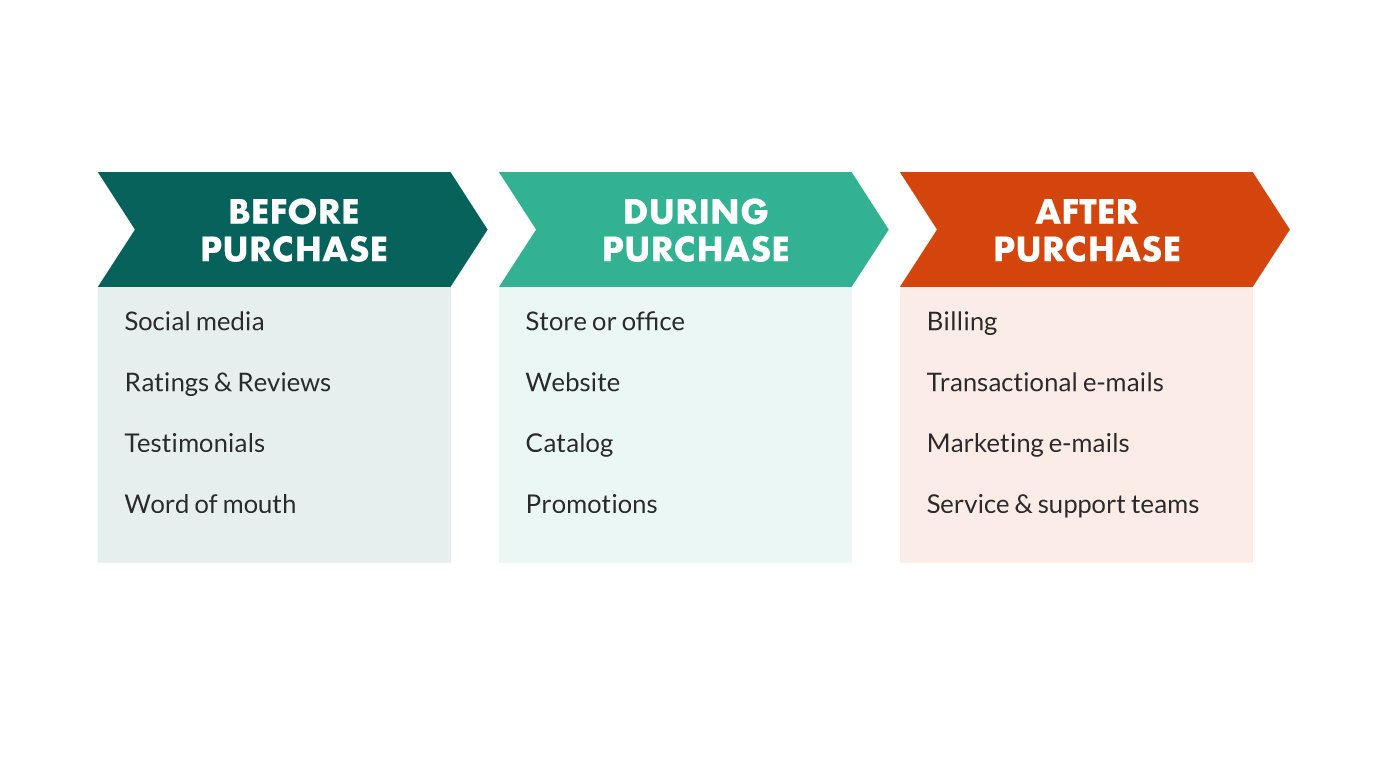
Broken down, the customer journey consists of 7 phases; Out of market, trigger, initial brand consideration, active evaluation, purchase decision, experience and loyalty.
Let’s take a look at each phase (and the customer’s mindset) in more detail – starting with the out-of-market phase. In this example, we’ll be viewing the customer journey from the perspective of a B2B buyer.
1. Out-of-market phase
In the out-of-market phase, the customer is looking to improve their business. They want their company, department or team to be more productive and more efficient. At this phase, they may not know how to achieve these goals, but they are open to inspiration.
2. Trigger phase
The trigger phase begins once the customer uncovers the opportunity to grow their business. It could be that sales are going down or that customer complaints are growing, but these indicators act as a trigger to changing the way they work.
3. Initial brand consideration phase
Once the customer identifies a solution to their problem, they will begin their initial search. A project group, involving all stakeholders will be formed to identify the top brands in their market, to scope the project and to review key functionality and technical requirements – leading to a “long list” of potential solutions.
4. Active evaluation
The long list becomes a short list once the initial brand review is complete. The customer will then contact each vendor and invites them to a meeting or demo. After the demo, the customer will review solutions based on trust, expertise and scalability.
5. Purchase decision phase
The customer chooses a vendor, agrees on a solution and signs the contract. The implementation process begins and an internal “roll out” team is formed. With support from the solution provider, the customer outlines success criteria, KPIs and launch timeline.
6. Experience phase
The customer wants to get the solution up and running quickly and for the launch to be as smooth as possible. This involves making sure all users are fully trained and have access to a consultant or account manager for support (when they need it).
7. Loyalty phase
After the initial roll out, the customer is happy to see fast results. The provider continues to follow up, implements the solution company-wide and and continues to help the customer reach their goals.
Mapping the customer touchpoints
If the journey is the mindset of a customer...
...then the touchpoints are the path he/she takes to engage with a company at each phase.
Mapping the touchpoints, and putting the right content assets and distribution channels to each phase of the journey is one of the most important factors of future digital initiatives, according to a survey by Regalix.
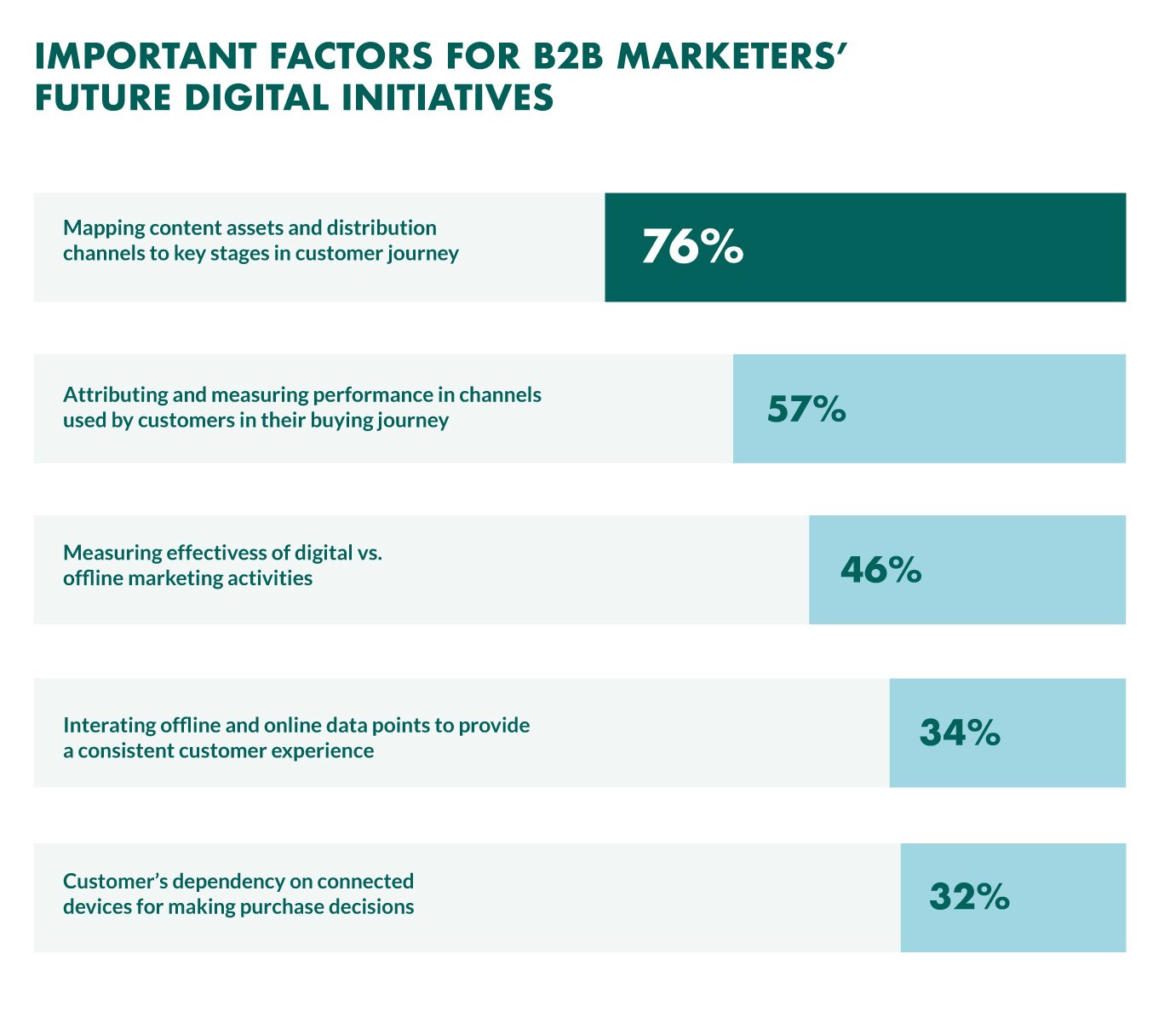
In the example below, we’ll explore the touchpoints based on a journey for a B2B customer.
- Out-of-market: Open to inspiration, the customer attends industry conferences, reads thought leadership content and stays updated on new trends via social media.
- Trigger: Being proactive, the customer uses Google search, video platforms (i.e. YouTube) and reads more niche blogs.
- Initial brand consideration: With a long list of providers, the customer visits company websites, comparison sites and review platforms.
- Active evaluation: Trust is important, so the customer downloads research papers from the vendor, reads in-depth case studies and customer references. Before requesting a live demo.
- Purchase decision: Dealing directly with the sales team, the customer signs the paperwork.
- Experience: The implementation phase begins, and the customer is given access to onboarding material, which includes user guides, training documents and product videos.
- Loyalty: The solution is rolled out company wide and when needed, the customer has access to phone and email customer service teams, live chat on the website, self-service support and a knowledge base.
It’s, of course, a simplified version of the customer journey and its key touchpoints. But it shows how important it is for a company to be actively present where its potential and existing customers are.
- Do you actively speak at industry conferences?
- Is your business listed on vendor comparison websites?
- Is your website visible in Google search?
If you answered ‘No’ to any of the questions above, then chances are that your potential customers simply won’t find you.
Said another way…
If you don’t base your strategy on the customer journey, then you will lose out on new business.
Aligning your strategy with the customer journey
Now that you have drawn out the customer journey and touchpoints from your customers’ perspective, you can now map out the touchpoints you use to try to reach your customers today, based on your existing business strategies – allowing you to identify the gaps.
A simple table can work for the gap analysis exercise.
For example, today we use direct mail to reach out-of-market buyers and use social media as a way to engage with prospects in trigger phase.
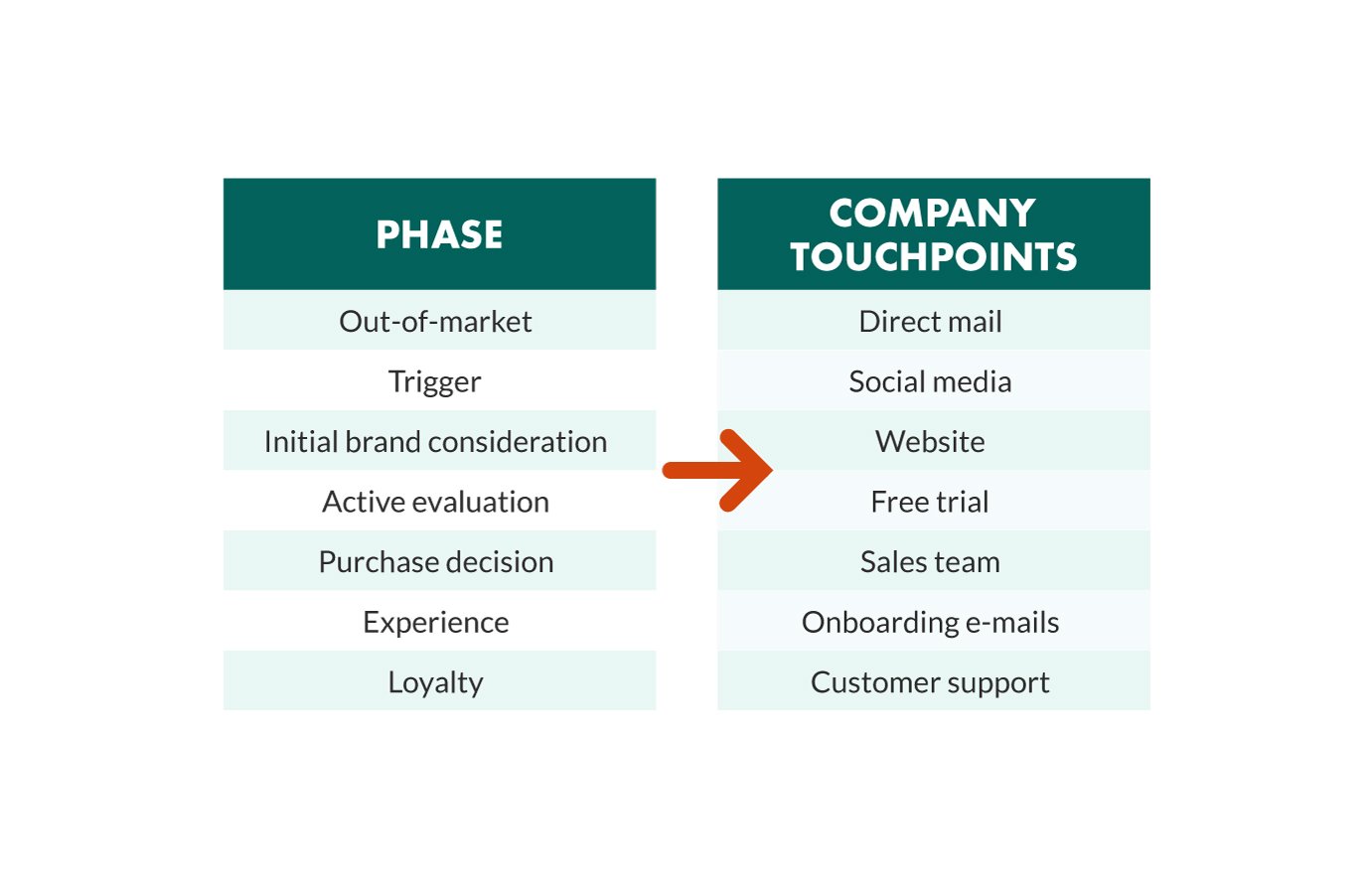
Once you have mapped out existing touchpoints, you can then layer them on top of your customer’s touchpoints, providing you with an overview of what you’re currently doing today versus what you should be doing to reach your customers.
Now, if you’re a customer-centric company, you should get an exact match with your strategies lining up exactly with the customer journey. Sales and marketing teams are aligned, customer churn is low and your customer base is happy and loyal.
However, if you’re not customer-centric, there will be a mismatch in activity and expectations.
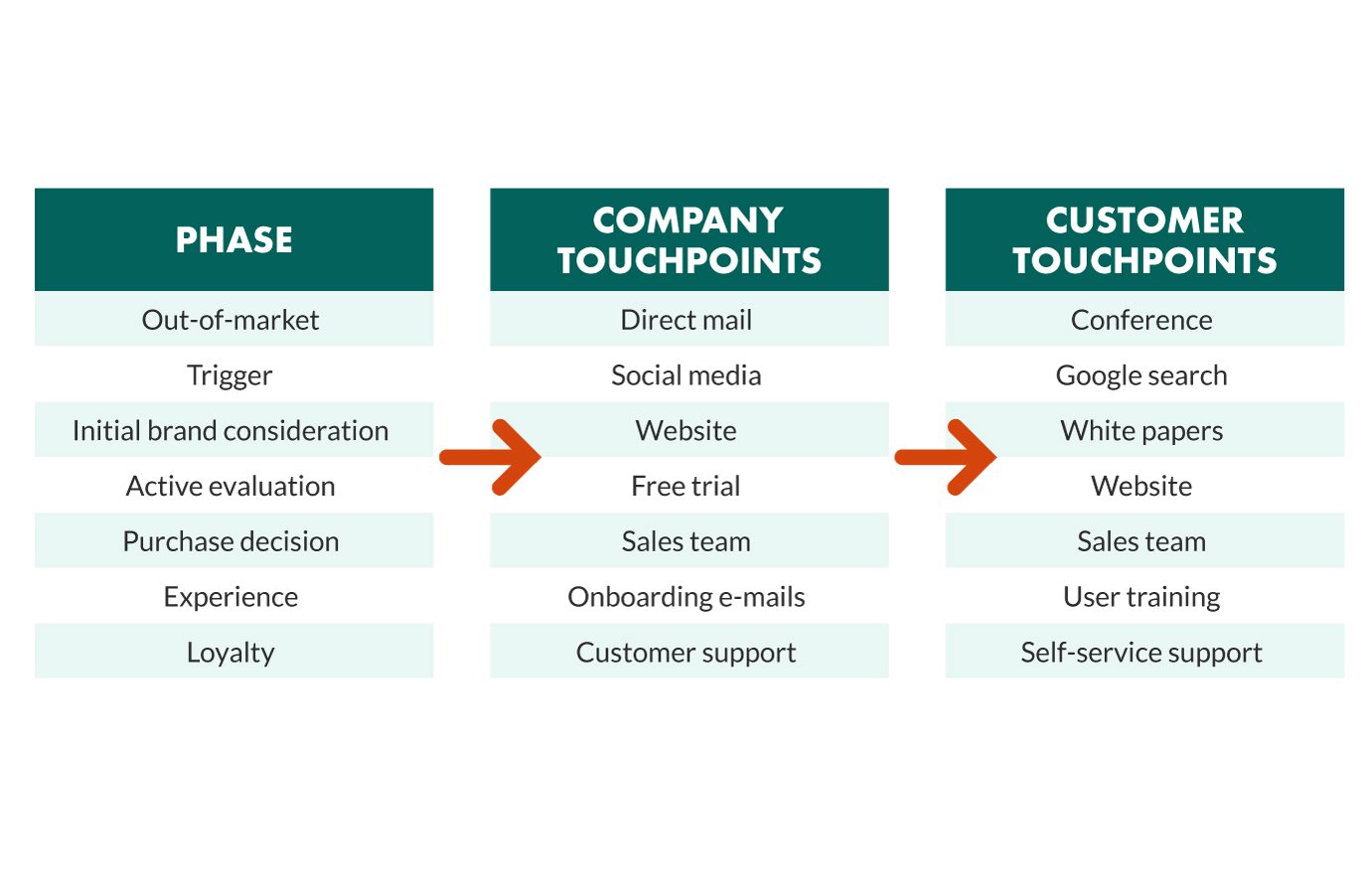
Once you have completed this exercise, what’s likely to happen is that you will notice two key points:
- You are spending too much time on activities that don’t impact the customer journey.
- You are spending too little time on activities that do impact the customer journey.
Based on this, you need to prioritize what you do based on what's more important - activities that align with journey versus activities that don't align with the journey...
Now, here comes the easy part:
Scrap all the activities you are currently doing that have no impact on the customer journey and double down on activities that do – because the more often you can meet the customer at each stage of the journey, the more likely they are to do business with you.
Conclusion
The power has completely shifted from brand to consumer.
And while the customer journey might be a new term, it won’t be long before it becomes critical to your business strategy.
Putting the customer at the heart of your organization is no longer a “nice to have”, it’s an entry level requirement to having a successful business in 2021.
Today, two out of three companies do not map their strategies to the customer journey – giving you a huge competitive advantage, if you take it.
For those companies that have a customer journey strategy in place, they’ve been able to reduce costs, improve sales performance and are overall, much more profitable.
New to SuperOffice CRM? Learn more about our award-winning product, described as "the world's most user-friendly CRM system" by signing up to a personalized demo.
Customer also ask
How can a company effectively track and measure the success of each stage in the customer journey?
To effectively track and measure success, companies often use a combination of analytics tools and customer feedback mechanisms. Key performance indicators such as conversion rates, time spent at each stage, customer satisfaction scores, and churn rates are typically monitored.
For example, in the awareness stage, metrics like website traffic and social media engagement can be insightful, while in the decision-making stage, conversion rates and sales metrics become more relevant. Additionally, gathering direct feedback through surveys and customer interviews can provide qualitative insights into the effectiveness of the journey at different stages.
What specific challenges do companies face when trying to align their sales and marketing strategies with the customer journey, and how can these be overcome?
One of the primary challenges companies face in aligning these strategies is ensuring consistent messaging and communication across all touchpoints. This often requires breaking down silos between departments and fostering a culture of collaboration.
Overcoming these challenges involves regular cross-departmental meetings, shared goals and metrics, and integrated customer relationship management (CRM) systems that provide a unified view of customer interactions. It's also crucial to have a clear understanding of the customer profiles to ensure that both sales and marketing are targeting the same audience with cohesive strategies.
How do companies tailor the customer journey for different market segments or customer personas?
Tailoring the customer journey for different segments or personas involves first understanding the unique needs, preferences, and behaviors of each group. This can be achieved through market research and data analysis. Companies then customize the journey by creating targeted marketing campaigns, personalized communication, and specialized product or service offerings.
For instance, a segment that prefers digital communication might receive more online ads and emails, while another that values personal interaction might be targeted with direct sales calls and in-person events. The key is to ensure that each touchpoint is optimized to meet the specific expectations and requirements of each segment or persona, improving the overall customer experience.




